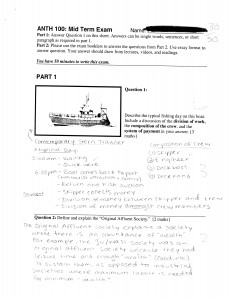[These notes connect with the lecture on Kinship and Family – audio notes]
Families can be described as “sites of reproduction” – this can be the case in two senses: People as individuals and people as future labour power.
Families, loosely defined (often times in anthropology we will say household – the group that is co-resident and share productive and consumptive activities) are the social institutions that typically produce people. Families tend to be the foundational unit of society that contributes toward the socialization of children and youth and acts as a primary site for the construction of social identity.
A lot of family studies -even anthropological research- examines the nature and structure of families as a way to understand what makes particular individuals the way they are. Educational studies of student success very often highlight family structure as being strongly correlated with student achievement. Not surprisingly the so-called white middle class family – two parents, two or three children, parents educated in some manner beyond high school- tends to produce higher rates of educational attainment in children. There is a problem, however, with such a limited approach. This is an example of a type of study that doesn’t place the object of study within the wider dynamics of structural power, but simply looks at the organizational power within the family unit.
Two basic critiques can be offered:
- Educational success is predefined in such a manner, located within a particular cultural understanding of what success is, as to be in some sense a self-fulfilling prophecy
- Empirical evidence shows other factors play as strong, if not stronger, a role in shaping education outcomes than family structure alone. For example, research at UBC in the Faculty of Education has shown that rather than family structure, household income is a far better indicator of educational success than any other factor. Using real estate appraisals one group of researchers has shown that the higher the house values the higher the likelihood of the household’s children going on to post secondary education.
What we can see here is that while the structure of a family may have some bearing on outcomes for children, the structure itself is neither the causal factor nor the only one that has a role to play. We need to take into account the wider ideas of “structural power” that Eric Wolf describes. We need to locate families within wider processes of society to understand what is actually happening.
So here we see that simply looking at the family as a unit the produces individuals misses a significant part of the overall picture. This takes us to the second aspect of reproduction – the reproduction of labour power that occurs within the family.
In the late 1960s a group of theorists, around a political campaign called “Wages for Housework” argued that the primarily female labour used to maintain the home and to raise children was actually a benefit being transferred to the capitalist system itself. Their argument went as follows: women cook, clean, parent, manage the household, provide services for their partners. All these activities can be costed in the larger labour market. If their partners, or the firms that employed their partners, were to pay for these services it would result in a sizable amount of money.
This argument was also relied upon a conception of the role of patriarchy, a gender ideology that places domestic power and authority into male hands, in shaping domestic relations. Their point was not that capitalism requires women’s unpaid labour in the home, but rather that capitalism as an economic system was able to adapt and deploy women’s unpaid labour in the home as a benefit to the accumulation of profits by reducing the amount of money businesses would have to pay their employees. Thus, a pre-existing patriarchal gender ideology (that disadvantaged women) was deployed by capitalism to transfer the responsibility for the maintenance of labour power and the reproduction of future labour power from capital to individual women doing unpaid labour in the home.
Privatized care of children in the home – that is raising children as a ‘choice’ and without significant societal support, is also a cost transfer from capital to individual families. That is, the costs of producing, raising, and preparing future labour power are transferred primarily to the domestic unit. This is a critical point as it shapes public debates about childcare and education. The dominant ideology places raising children into a private domain of individual choice and responsibility. Yet, from an empirical sense, capital saves money by transferring as much of the cost of raising and educating children as it can into families. Thus, the countervailing or more balanced argument tends to highlight the overall societal benefit that families provide by raising children and sees the provision of childcare services (either through socialized daycare or parental release with pay) as a society obligation rather than as an individual responsibility.
So, by maintaining women’s labour in the home as unpaid, by transferring the cost of the reproduction of labour power into the home, and by highlighting ideologies of individual responsibility above collective obligations the structural power of social class reproduces a wide range of social inequalities. Keep in mind that the wealthier members of society can purchase labour power to replace their own personal labour in the home. So, for the wealthy, the privatization of labour within the family does not directly affect them, or at least it affects them in a quantitatively and qualitatively different manner than working class or poorer families. The end result becomes a transferring of critical aspects of societal responsibilities onto the backs of those least able to pay and then telling them that it’s their fault.
A rather back to front situation if ever there was one.


